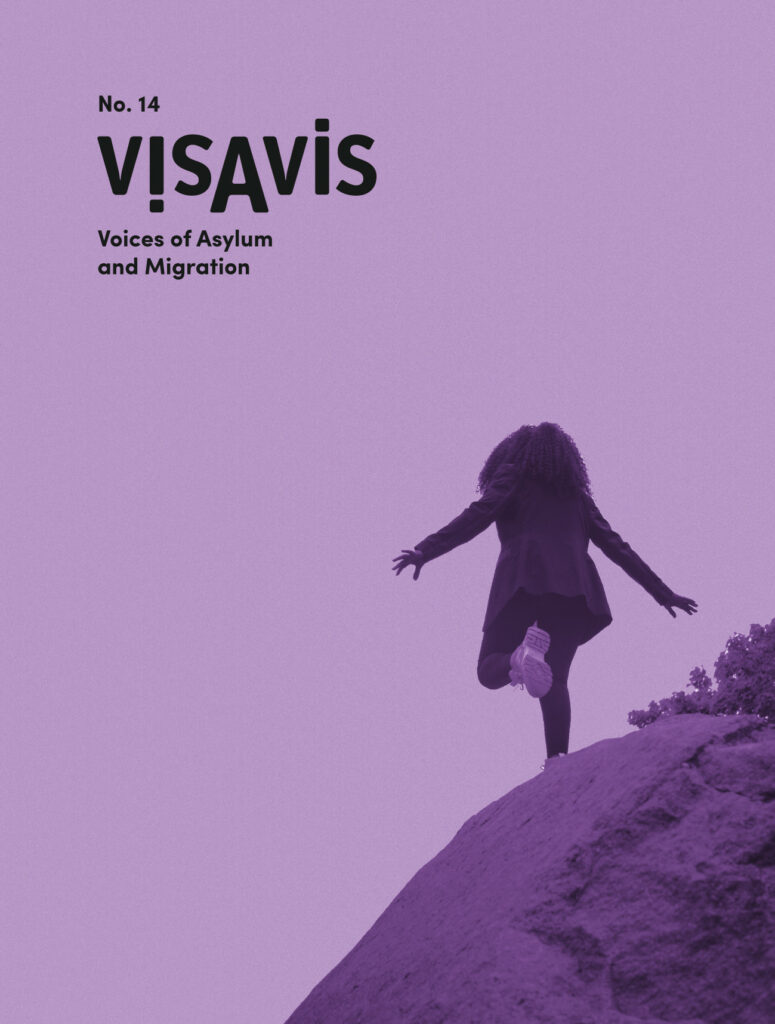When you exit the metro at Christianshavn in Copenhagen you see a number of statues known as the Greenland Monument. They were made from red granite by the Danish sculptor Svend Rathsack after he had spent six weeks in the arctic colonies in 1931.
by Kristian Vistrup • 2016

Around the same time there had been some controversy around the Danish presence in eastern Greenland – Norway also had colonial ambitions – so perhaps that helped the municipality’s decision to sponsor the work. The monument centres on a hunter with his kayak, standing proud and erect in the middle of the square on a tall, slender pedestal. On either side of him, closer to the ground, two clusters of women are working: one skinning a seal, another cleaning cod, catching small salmon with a net, keeping watch. Resting on the kayak is an inflated pig’s bladder. Svend Rathsack was a sculptor of the neoclassicist school.
Underneath this noble savage, the postcolonial social case. Frequently drunk, mostly homeless Greenlanders have found a place to lean and to gather by the statues. Do they feel celebrated by them? Honoured and proud by this recognition in the capital? Do they come here because they feel at home under the kayak, or to protest the obscenity of it? A half-live diorama, they figure a violence rarely spoken about. We, the Danes, only know Greenlanders like this, drunk or mythical, mythically drunk, and by association from the little figurine on the queen’s bureau, carved from tusk or bone that we see when she gives her speech on New Year’s Eve. Sometimes the little princes and princesses go up there to wear kamiks and colourfully embroidered collars and play with sleigh dogs. There is a colonial relationship here that remains insufficiently addressed and insufficiently post – it is embarrassing and offensive. It is convenient for us, the Danes, that Greenland and Greenlanders remain neatly within this benign binary, but between the statues and the people at Christianshavn there is something else going on. Something at once unresolved and defiant; a being there that refuses to recede into the background. As if fire could be produced from the friction between flesh and stone.
‘The one who goes to the mountain’, it means, in Greenlandic: Qivittoq – a dark and mysterious outline against the white of the ice – but it also functions in language like: don’t go qivittoq. Please, let’s make a pact to stop each other from ever going qivittoq. It happens when the heart breaks, from unrequited love or losing face. You simply leave your village and go to live on the mountain until you die (which you will do pretty quickly, in the cold). According to myth, he – for it is always a man – who goes qivittoq will in time be taken over by the spirits of nature, and return to the village with the wind to seek revenge for the injustice that led to his departure. Qivittoq is the appeal of exodus as political strategy, a gesture somewhere in between defiance and defeat, as well as a thinly veiled discourse on suicide, a different name for someone who is no longer wanted.
The first ever Greenlandic novel was Sinnattugaq (The Dream) by Mathias Storch published in 1914. Although he was not educated in Denmark, to the dismay of his Danish colleagues Storch became the first Greenlander to be appointed pastor. Storch lived in Illulisat on the west coast of the island where, today, one of the world’s greatest glaciers is melting away. At the time he was considered one of the most important Greenlandic voices in the political debate. In Sinnattugaq, the two friends Pavia and Silas make this pact: to promise to stop the other from ever going qivittoq. But, when Silas loses the girl he loves to his brother, Pavia is away for schooling in Nuuk, unable to stop him. Silas goes to the mountain. Devastated upon receiving the news, Pavia is about to go qivittoq himself, when he falls asleep over his books and has a dream: Greenland, 200 years later, is enlightened, educated, bilingual and independent. A wakeup call to end colonial humiliation. From then on, Pavia dedicates himself to the cause.
In the 1915 introduction to the Danish translation, the reader is warned not to expect any literary finesse from the novel – ‘for in that, one would put too great and unjust demands on a Greenlandic author’ – but, it is acknowledged, Storch never intended it for Danish readers. More so than any issues pertaining to finesse, perhaps this was the problem: literary independence.
The enlightenment of Greenland didn’t happen quite as Storch had imagined. Rather, like a summerhouse in winter, the colony fell into disrepair while Denmark was occupied during the Second World War. After a devastating tuberculosis epidemic, the Danish government came under pressure from the United Nations in the early 1950s to prove that it could still manage the island. This pressure was fuelled by increasing interest in the territory from the United States, causing some desperation for the tiny colonising power. As an experiment, a group of children were taken away from their families in Greenland to learn Danish language and customs. They would forget their own language and have their skin bleached under bright lights, before being carefully reinserted into the society they came from. Lighter, brighter, more civilised, they were intended as models for other children to aspire to. In this, one of the darkest moments in Danish colonial history, it becomes clear that enlightenment was never a metaphor, it’s a procedure.
Around the same time, Storch’s story was loosely adapted for the screen featuring Danish cinema’s favourite heartthrob of the decade, Poul Reichhardt, and a rich measure of racial stereotyping. Qivitoq, as the film was called – there is some disagreement about the spelling – was a great spectacle of colonial exoticism, and the first Danish film to be nominated for an Oscar. If this honour is any indication, US-incited UN qualms about Danish rule in Greenland had been appeased, and the qivittoq twisted by the arm in the process.
A lecturer of cultural studies at the University of Copenhagen, Kirsten Thisted suggests that in using the trope of the qivittoq in his novel, Storch is responding to a precedent set in late 19th century Scandinavian literature about Greenland. In fact, the Greenlanders themselves have time and time again criticised the qivittoq-motif, and revealed it as mere superstition and a vehicle for slanderous gossip about suspected suicides. Thisted argues that the use of the theme in Danish colonial literature has remained consistent all the way up to Peter Høeg in the 1990s. His book Miss Smilla’s Sense of Snow won some international acclaim, and appeared on screen the world over in 1997 with the British actress Julia Ormond in the role of Smilla, an inuit woman –perhaps to have a Greenlander play the part would have been to posit too great and unjust demands, or perhaps there was just no time to bring the bright lights back out.
It is easy to see the appeal of the qivittoq to the colonial subconscious: the mysterious native, possessed by the untameable powers of nature. Also: the qivittoq leaves! Throws in the towel, gives up, and it’s cold—nobody knows about the spirits, but everyone is sure of the cold, that it will kill you. Exodus might be a powerful gesture, but as a political protest, it is impotent. Impotent and mysterious, that’s how the Danes like their Greenlanders. So much so that the problem of homeless, alcoholic greenlanders is often read by Danes as a modern day qivittoq. Based on the scene at Christianshavn, I disagree. Those Greenlanders are not going to the mountain, they are,precisely and adamantly staying in town. Remember, there is friction.
Like Storch, Niviaq Korneliussen first published her novel HOMO Sapienne in Greenlandic, but unlike him, she translated it into Danish herself. She wrote it for the other young people in Greenland, she said in an interview to Danish Radio, wrote it for the gay, bisexual and trans communities, and to say nothing about nature and nothing about alcoholism. It remains defiantly in place, in sexual encounters, in heated politics; in HOMO Sapienne there are none of the detached observations, no qivittoq, out there, freezing to death. Here is a recipe for keeping warm in cold country: stay by the fire. One of the characters writes in his diary (my translation): ‘the island has run out of oxygen, the island is festering’. So he has to leave for Copenhagen. Not that he likes the Danes, or wants to be like them or liked by them – he doesn’t think they are fun – but as a young queer person, what else can he do? He continues: ‘our country, which is ancient, go to the mountain and never come back, stop being so fucking pretentious.’
His leaving is a rejection of the qivittoq-motif. In a mode of confrontation, he breaks the pact; lets the land collapse onto the mountain if it wants to, but he has no choice but to tackle what is already there among the houses and the people. It is worth noting again that the qivittoq is always the strong male, always the hunter with the kayak on the tallest pillar in the middle of the square. Also Rathsack was very specific about which fish the women statues are catching with their nets: the angmagssak, a small, almost see-through type of salmon that comes close enough to be reached from the shore. Not the mountain: the shore, the town, the centre, when you come out of the metro, is the best place to be, and to be seen to be, antagonistic. Keep close, keep watching out, keep rubbing up against the structure, because what else can you do to stay warm?
